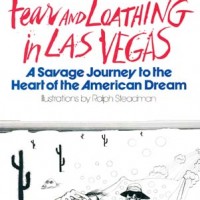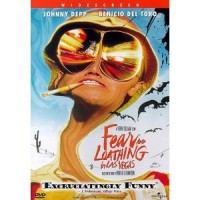LiterList #1: Good Novels That Turned Into Pretty Good Films part 2
- Details
- Published on Tuesday, 13 September 2011 16:49
- Written by Kevin Kizer
Fear and Loathing in Las Vegas
The Book
Just like our previous novel, "Fear and Loathing in Las Vegas" was writer Hunter S. Thompson's second published book. His first book, "The Hell's Angels", was far more journalistic as it was the first detailed expose written from within the motorcycle club.
But in "Fear and Loathing..." Thompson decided to release a new gonzo style on the world.
What turned out to be "Fear and Loathing in Las Vegas" started out as something completely different – Thompson had been hired by Sports Illustrated to cover the annual Mint 400 desert race in Las Vegas with a photographer. But with the addition of his friend Oscar "Zeta" Acosta, a radical, militant lawyer, and a trunk load of high-powered drugs and weapons, the trip and story quickly turned "gonzo". What is "gonzo journalism" as Thompson called it? It's when the writer inserts his life, opinions and reality into a story – relatively common now. In that sense, the writer becomes the story and in "Fear and Loathing..." Thompson and Acosta certainly take center stage.
The story itself is pretty well known – Thompson ("Raoul Duke") and Acosta ("Dr. Gonzo") head to Vegas to cover a motorcycle race but instead find themselves on, as the book's subtitle states, "A Savage Journey to the Heart of the American Dream" which includes run-ins with quite a few tourists and a visit to the National District Attorneys Association's Conference on Narcotics and Dangerous Drugs (or NDAACNDD for short?). The story is actually based on two trips the pair took to Vegas in 1971 but Thompson condenses them into one for the story (similar to "On The Road").
After the first trip, Thompson locked himself in a hotel room and produced the first manuscript on the race in a 36-hour marathon writing session. Undoubtedly, Sports Illustrated was not expecting the type of story Thompson wrote – in fact, they really only wanted photo captions. But Thompson had other ideas. The second trip to Vegas came about when Acosta learned of the NDAA event, which became the second half of the novel. The novel first appeared in Rolling Stone as a two-part article written by "Raoul Duke" and featured what have now become the familiar Ralph Steadman illustrations.
From a structural standpoint, while there is a narrative, it bounces back between the real and surreal depending on the characters' state of inebriation or the type of drugs they have ingested – everything from LSD and marijuana to cocaine and ether. Why? The book's preface – a quote from Samuel Johnson – states the purpose: He who makes a beast of himself gets rid of the pain of being a man. Thompson believes that he has, in those trips to Vegas, that he is seeing the death of the American Dream. Here's a portion of the novel's oft-quoted "Wave" speech:
"Strange memories on this nervous night in Las Vegas. Five years later? Six? It seems like a lifetime, or at least a Main Era—the kind of peak that never comes again. San Francisco in the middle sixties was a very special time and place to be a part of. Maybe it meant something. Maybe not, in the long run ...but no explanation, no mix of words or music or memories can touch that sense of knowing that you were there and alive in that corner of time and the world. Whatever it meant...
So now, less than five years later, you can go up on a steep hill in Las Vegas and look West, and with the right kind of eyes you can almost see the high-water mark —that place where the wave finally broke and rolled back."
As is the case with most of the novels that will be included on this list, "Fear and Loathing..." burst onto the literary scene because of Thompson's unique style and voice, as well as his insights. He could see through the haze of money and greed. This became even more apparent in "Fear and Loathing on the '72 Campaign Trail" which stands today as the preeminent and most insightful piece ever written on a presidential election.
LITERAREA BOOK RATING: 7
The Film
The film adaptation of "Fear and Loathing in Las Vegas" floundered for years, with directors such as Martin Scorsese and Oliver Stone taking their cracks. At one point, Jack Nicholson and Marlon Brando were considered for the lead roles, along with Dan Aykroyd and John Belushi. Monty Python alum Terry Gilliam, who is known for his flamboyant and creative movies, took over the task in the '80s and finally, in 1997, was able to get a script that he felt captured the story properly.
The movie came out in 1998 with Johnny Depp and Benicio del Toro as the lead characters. What's striking was Depp's transformation into Thompson. in his youth bear a striking resemblance to a young Johnny Depp, who spent a lot of time with Thompson preparing for the role (according to Thompson, he kept Depp in the basement of his "heavily fortified compound" called Woody Creek). To prepare for his role as the portly Acosta, del Toro ate. And ate. And ate. Mainly donuts. Alongside Depp and del Toro, other noted actors make appearances – Tobey Maguire, Ellen Barkin, Christina Ricci and Cameron Diaz – along with some noted non-actors – Flea, Lyle Lovett and the author himself.
Because of Gilliam's experience as an animator over the years, he was able to bring to life rather effectively the more psychedelic aspects of the novel, including the famous opening scene where we find our main characters "somewhere around Barstow on the edge of the desert when the drugs began to take hold." And at that point we are off on the drug-fueled trip that hardly lets up for a second.
Compared to the book, the movie stays true to the source material. Every line (except for one notable exception*) is straight from the book and only a few sections of the novel had to be omitted. The movie itself is garish and intense. While it flopped in the theater, it has become a cult classic over the years. The movie has been called a "follow up" to "Easy Rider" and it's easy to see the comparison between Duke and Gonzo and Wyatt and Billy.
In 2003, The Criterion Collection released a special edition of the film including a commentary track by Hunter S. Thompson, which apparently takes places after midnight at his Woody Creek compound with his wife and agent. While the movie itself is a wild ride, watching it with the Thompson's commentary track is even wilder. He points out bits he doesn't like and enjoys mocking Gilliam and his "goddamned cartoons" throughout the movie. He even calls up Depp and del Toro leaving them filthy and threatening voice mail messages. In other words, just Thompson being Thompson.
* in the scene where Thompson gets pulled over by highway patrol, Gary Busey adlibs "May I have a little kiss before you go? I'm very lonely out here." Which incensed Thompson at first.
LITERAREA FILM RATING: 8
OFFICIAL OVERALL LITERAREA RATING: 9
This is one of the few novel/adaptations where the movie actually enhances the novel in some sense. So much of Thompson's writing blurs between the real and surreal that any film adaptation would be remiss in trying to avoid. It probably is a good thing this movie wasn't made in the '70s and '80s as portraying the psychedelic scene would have been even more difficult (one recoils at the thought of "psychedelic effects" in '70s film). What's most important is that Gilliam stayed true to the written word, which is something our next novel adaptation did not do – much to its credit.
Coming Soon:
THE GODFATHER
A CLOCKWORK ORANGE



















































